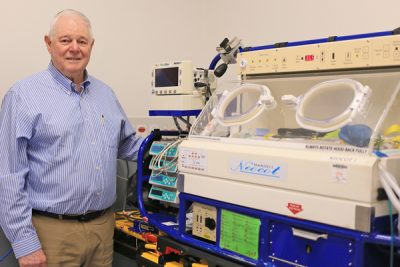Engineering the safe transport of 4000 babies
 In the space of around two decades, a simple student project has grown to help save the lives of almost 4,000 babies at Royal Brisbane and Women’s Hospital alone.
In the space of around two decades, a simple student project has grown to help save the lives of almost 4,000 babies at Royal Brisbane and Women’s Hospital alone.
The neonatal retrieval transport cots -developed in the late 90s by engineer Professor John Grant-Thomson AM RFD, then RBWH Director of Neonatology Dr David Cartwright and Mater Director of Neonatology Dr David Tudehope – have been utilised since early 2000 and are now in neonatal retrieval units across the country.
The cots are used not only in Australia but also in Europe with inquiries from the UK and USA.
John was approached by David at RBWH after making adult systems for the Army, and was amazed at how large the current transport systems were for such tiny patients.
“These huge transport systems were nearly 200kg and the babies were barely 1kg,” John said.
“I thought, why are engineers born if we can’t do something about it? I started a student project at the University of Southern Queensland to improve what I saw. The Neocot is the result you see today.”
David said John was determined from the start.
“He came to us and we didn’t know what he was on about, but we thought hey, if he is keen then we’d give it a go,” David said.
“It was quite revolutionary as it was lighter than what we had… he has continued to make adjustments and changes over the decades so we can transport babies safely and efficiently.”
Fittingly, John was also born at RBWH.
“John certainly has his own contribution to that legacy,” David said.
Professor John Grant-Thompson AM was a finalist in the 2019 Queensland Senior Australian of the Year Award.
